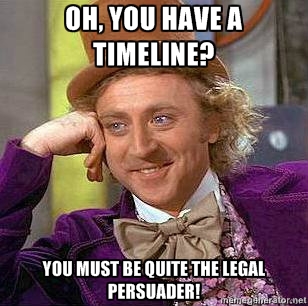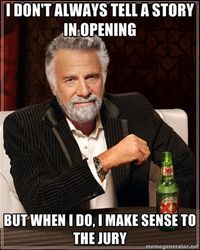By Dr. Ken Broda Bahm:
If you aren’t on Facebook, you may not have seen this before (and if you are, then you might see it, with different words, just about every day). The image and text above is called a “meme,” the “Condescending Wonka Meme” in this case. It’s a joke, of course, but borrowing from the language of biologist Richard Dawkins, the “meme” label refers to an image that conveys a quick and simple message that can then be mutated, customized, and passed along by sharing. Originating in photo sites like 4chan, memes have now taken over Facebook to become one of the most common ways people communicate in that setting. Users are able to pick a recognizable image from movies, video games, sports, television, or another pop culture setting, and add a pithy statement often reflecting something currently on the national agenda. For example, a common “Condescending Wonka Meme” right now carries the caption “Gun laws would prevent shooting sprees? Please, tell me more about how criminals follow laws,” starting many a debate on Facebook.
Since nothing escapes academic attention, there’s now a raft of articles, theses, and chapters (e.g., Buchel, 2012 or Knobel & Lankshear, 2007, p. 199) focusing on the ways these innocuous-looking postage stamps of meaning are transmitting group identity and changing cultural literacy. As the latter article explained, “The
power of memes to spread contagious ideas and to infect minds with particular
ideas is widely recognized and entire groups have begun experimenting with meme
engineering and distribution on quite significant scales.” Now, since I’m writing about this on the morning of Christmas eve, I don’t want to get too serious about it. Yet, the more I see these memes on Facebook (ahem, I’m on Facebook for purely professional reasons…to look up jurors’ public profiles), the more I think about what memes can teach us about effective graphics in litigation. After all, these are messages and images that millions of average people are creating, modifying, and distributing themselves, so it seems like there is a high potential for at least a few takeaways.
For me, the interesting question is this:
What is it about memes that make them work?
Apart from the humor and sarcasm, of course, what is it that fuels the effectiveness of memes as a medium? To provide a simple illustration of the range of memes, I’m going to share a few tongue-in-cheek litigation-oriented example (see the end of this post for a link to some examples you would actually use in trial). Ultimately, I think there are four quick messages we can take from memes and apply to the images used to promote comprehension in trial.
One thing that sets memes apart from other content shared on social media like articles and blog posts is that they are visually and textually simple: never more than a single image and never more than a couple of lines of text. Contrast that with what usually ends up on the screen in trial: lengthy documents, tables of text, complex diagrams, and over-stuffed timelines. It is no wonder that jurors used to a simpler visual diet can be overwhelmed. “But cases that go to trial are complicated,” you argue, and that is true. But where you have the opportunity to make a single point with a simple image, take that opportunity. If you have a choice between making nine points with one graphic, or making one point each with nine graphics, pick the latter.
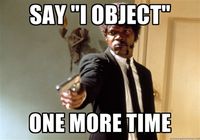 2. They’re a Complete Thought. Somewhere, maybe in the earliest days of PowerPoint, people developed the ineffective habit of topping an image with a “label,” or a “heading.” It is always better to top it with an argument, or at least a complete thought. In the case of memes, they never contain just a title. Instead, they make a point. Even where the point is simply implied, it is always clear enough to be understood by most of the audience. In litigation, for example, instead of topping your employment timeline with “Timeline of Events,” top it with “Smith Received Multiple Warnings.” Some judges may consider that too argumentative for an opening, and some won’t. After all, the purpose of opening is to preview what the evidence will show, and as long as it is presented in the context of a preview, the complete thought label shouldn’t be objectionable. But if it is, then change it to a question: “How Many Warnings Did Smith Receive?” The point is still clear.
2. They’re a Complete Thought. Somewhere, maybe in the earliest days of PowerPoint, people developed the ineffective habit of topping an image with a “label,” or a “heading.” It is always better to top it with an argument, or at least a complete thought. In the case of memes, they never contain just a title. Instead, they make a point. Even where the point is simply implied, it is always clear enough to be understood by most of the audience. In litigation, for example, instead of topping your employment timeline with “Timeline of Events,” top it with “Smith Received Multiple Warnings.” Some judges may consider that too argumentative for an opening, and some won’t. After all, the purpose of opening is to preview what the evidence will show, and as long as it is presented in the context of a preview, the complete thought label shouldn’t be objectionable. But if it is, then change it to a question: “How Many Warnings Did Smith Receive?” The point is still clear.
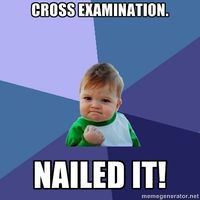 3. They’re Visual. We tend to think of arguments as textual (a claim, supported by data, with a warrant connecting the two together). But looking at the content of memes reminds us that arguments and other messages can be substantially, if not predominantly, visual. In fact, it is difficult to imagine that these memes would ever be widely shared, no matter how funny at a textual level, if it were not for the images. In litigation, however, too many attorneys still rely on charts, slides, and timelines that are primarily made up of text. Some level of text is fine, and in any case, necessary. But once the graphic is dominated by text, it forces the jury to become “readers” rather than “listeners,” and that reduces overall comprehension. Better to work from the default style of pairing one useful, relevant, but simple image with one single and clear message.
3. They’re Visual. We tend to think of arguments as textual (a claim, supported by data, with a warrant connecting the two together). But looking at the content of memes reminds us that arguments and other messages can be substantially, if not predominantly, visual. In fact, it is difficult to imagine that these memes would ever be widely shared, no matter how funny at a textual level, if it were not for the images. In litigation, however, too many attorneys still rely on charts, slides, and timelines that are primarily made up of text. Some level of text is fine, and in any case, necessary. But once the graphic is dominated by text, it forces the jury to become “readers” rather than “listeners,” and that reduces overall comprehension. Better to work from the default style of pairing one useful, relevant, but simple image with one single and clear message.
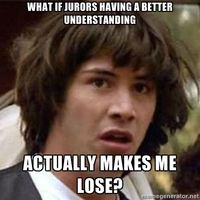 4. They’re Shareable. Of course, what makes a meme a meme is its tendency to be passed along and altered in the transmission. In contrast, your litigation graphic isn’t likely to be “shared” on a juror’s Facebook page (and if it is, you’ve probably got some mistrial problems). But there is one other way that jurors can end up “sharing” your graphics: They can remember and use the imagery during deliberations. Generally, of course, an exhibit that is admitted for demonstrative purposes only cannot be taken back to the deliberation room. But a memory and an understanding of that graphic is taken back, and the question should be, is the memory of the graphic clear and useful enough that it can play a role in deliberations? I recall one case I was involved in that used a complex map showing hundreds of agricultural fields, with links on each allowing data to be called up showing that field’s planting, irrigation, and fertilization history. Useful for the questioners and the experts? Yes. Memorable for the jurors? Probably not, unless it can be boiled to one single point.
4. They’re Shareable. Of course, what makes a meme a meme is its tendency to be passed along and altered in the transmission. In contrast, your litigation graphic isn’t likely to be “shared” on a juror’s Facebook page (and if it is, you’ve probably got some mistrial problems). But there is one other way that jurors can end up “sharing” your graphics: They can remember and use the imagery during deliberations. Generally, of course, an exhibit that is admitted for demonstrative purposes only cannot be taken back to the deliberation room. But a memory and an understanding of that graphic is taken back, and the question should be, is the memory of the graphic clear and useful enough that it can play a role in deliberations? I recall one case I was involved in that used a complex map showing hundreds of agricultural fields, with links on each allowing data to be called up showing that field’s planting, irrigation, and fertilization history. Useful for the questioners and the experts? Yes. Memorable for the jurors? Probably not, unless it can be boiled to one single point.
Of course, the advice to “make your graphics meme-like” can’t literally apply to everything you show. Documents still matter, schematic diagrams need to be complete, and timelines will include many different data points. But where you can, the recommendation is to pair a single written message with a simple recognizable image. Using some examples, I’ve blogged about this approach before, and reported on research showing that claims are viewed as more likely to be true when a meaningful image accompanies the claim. So, it may be the case after all that the meme is the message.
Image Credit: All images created via Meme Generator (http://memegenerator.net).
